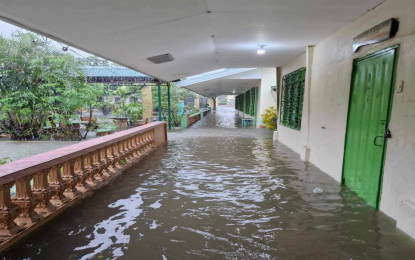
INNOVATION FOR DISASTER MITIGATION. A school in Ilocos Norte is inundated in floods caused by Super Typhoon Julian in this undated photo. During the 2024 Asia Pacific Ministerial Conference on Disaster Risk Reduction in Pasay City on Monday (Oct. 14, 2024), Interior Secretary Jonvic Remulla urged local government units to "act now and act fast" in implementing disaster risk reduction measures. (File photo courtesy of DepEd PH)
MANILA – Department of the Interior and Local Government (DILG) Secretary Jonvic Remulla has urged local government units (LGUs) to "act now and act fast" in implementing disaster risk reduction measures.
"We all need to act now. We have to act fast. We hope that through this Assembly, we will secure everyone’s commitment to plan and execute decisive and urgent local actions on disaster risk reduction and management more expediently," the DILG chief said at the Local and Regional Government Assembly of the 2024 Asia Pacific Ministerial Conference on Disaster Risk Reduction (APMCDRR) in Pasay City on Monday.
Remulla said the DILG, as the vice chair for Disaster Preparedness of the National Disaster Risk Reduction and Management Council (NDRRMC), would continue enhancing the capacities of LGUs on DRRM and climate change adaptation.
He said the DILG would continuously provide policy guidance, technical support and capacity interventions to LGUs to ensure that these are empowered and equipped to lead DRR efforts in their respective jurisdictions.
He reported that 87.87 percent of LGUs have already developed their local disaster risk reduction and management plans and 71.05 percent of local governments nationwide have established their local climate change action plans.
He said 67.93 percent of LGUs have contingency plans, and 87.33 percent have approved community-based disaster risk reduction plans.
Role of science, innovation
An expert highlighted the importance of science and technology innovation in disaster risk reduction management and mitigating losses.
Dr. Rajib Shaw, Professor and Chair of Environmental Design and Governance in Japan, and Chair of the Asia-Pacific Science Technology Advisory Group of the United Nations, pushed for mainstreaming science at all levels and making affordable technology accessible to local communities.
“We need to understand what people need. Of course, we need innovation, but innovation should start from there,” he added.
He said this is possible through enhancing multi-stakeholder engagement and urging collaboration among governments, civil society, and the private sector.
Businesses can be tapped for this initiative as these entities have the expertise, resources, and innovative technologies necessary to mitigate the impacts of disasters and climate change.
The private sector is seen as a crucial partner in building resilient communities, whether through developing local early warning systems or investing in disaster preparedness infrastructure.
Meanwhile, Shaw noted that in this time and age, countries should also focus on an all-hazards approach that also includes technological and biological hazards.
“We have seen that during Covid-19, how within that prolonged period of two and a half years or in some countries for three years, we had many repeated natural hazards which happened,” he said.
Shaw added that innovative techniques should also be considered when new types of hazards and risks emerge.
He also pushed for the institutionalization of disaster education to ensure the resilience of the future generation.
Regional cooperation needed
With the onslaught of natural calamities expected to worsen by 2030, Department of National Defense (DND) Secretary Gilberto Teodoro Jr. stressed the importance of regional cooperation to enhance prevention and response strategies.
“There is strength in numbers, in case of disaster risk reduction, particularly in case of response. Secondly, in early prediction of phenomena and thirdly, in exchanging best practices of what worked given a particular set of circumstances both locally and national. Likewise, you need some convergence within the regional economic and political infrastructure,” said Teodoro, who is also NDRMMC chair.
Teodoro also cited the need for vigilance against disinformation that undermines disaster risk reduction measures.
The APMCDRR, with the theme “Surge to 2030: Enhancing ambition in Asia Pacific to accelerate disaster risk reduction”, is the largest biennial gathering aimed at accelerating progress in reducing disaster risk in the Asia-Pacific Region.
The gathering, convened by the United Nations Office for Disaster Risk Reduction, aims to facilitate the exchange of practical solutions, promote inclusive disaster risk governance, and enhance resilience in Asia and the Pacific. (with Priam Nepomuceno/PNA)
